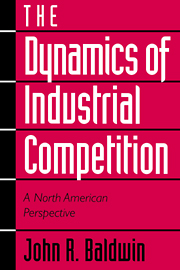Book contents
- Frontmatter
- Contents
- preface
- Acknowledgements
- 1 The dynamics of competition
- 2 Greenfield entry and closedown exit
- 3 Entry, exit, and the merger process
- 4 The rise and fall of incumbents
- 5 Patterns of large- and small-firm mobility
- 6 Plant turnover in Canada and the United States
- 7 Measures of market structure and the intensity of competition
- 8 The relationship between mobility and concentration
- 9 Turnover and productivity growth
- 10 Merger success
- 11 Turnover in domestic and foreign enterprises
- 12 Industry efficiency and firm turnover in the Canadian manufacturing sector
- 13 Firm turnover and profitability
- 14 Modelling entry
- 15 Conclusion
- Appendix A Measuring firm turnover – methodology
- Appendix B Definition of concentration and mobility measures
- Notes
- References
- Author index
- Subject index
Appendix A - Measuring firm turnover – methodology
Published online by Cambridge University Press: 30 March 2010
- Frontmatter
- Contents
- preface
- Acknowledgements
- 1 The dynamics of competition
- 2 Greenfield entry and closedown exit
- 3 Entry, exit, and the merger process
- 4 The rise and fall of incumbents
- 5 Patterns of large- and small-firm mobility
- 6 Plant turnover in Canada and the United States
- 7 Measures of market structure and the intensity of competition
- 8 The relationship between mobility and concentration
- 9 Turnover and productivity growth
- 10 Merger success
- 11 Turnover in domestic and foreign enterprises
- 12 Industry efficiency and firm turnover in the Canadian manufacturing sector
- 13 Firm turnover and profitability
- 14 Modelling entry
- 15 Conclusion
- Appendix A Measuring firm turnover – methodology
- Appendix B Definition of concentration and mobility measures
- Notes
- References
- Author index
- Subject index
Summary
The study of firm turnover requires longitudinal databases that measure firm performance over time. These databases need to be comprehensive and reliable. Databases that are constructed only from the records of those companies that wish to be placed on files used for credit-rating purposes – like the Dun and Bradstreet records used by Birch (1979, 1981) and the U.S. Small Business Administration (1984) – are incomplete (see Johnson and Storey, 1985). Other databases, like the ones constructed by Storey (1985) and his colleagues in the United Kingdom, are built from different sources, none of which purports to be a complete census.
Problems can also arise with longitudinal databases if coverage is not current or if it changes over time because of a lag in adding new firms to a database or in purging it of firms that have exited. Sudden bursts of activity to catch existing firms that may have been overlooked or to purge the files of defunct producers can distort measured entry and exit.
Measuring entry and exit with the Canadian Census of Manufactures overcomes these problems in large part. First, these data are comprehensive in that they cover all firms in the manufacturing sector. Second, they are reliable. Third, they are timely, since the Canadian census is done annually. An effective method of finding new plants and firms exists – through the use of administrative tax files. Moreover, failure of a previously existing producer to file a census return is followed up by trained personnel to ascertain the status of the firm or plant.
- Type
- Chapter
- Information
- The Dynamics of Industrial CompetitionA North American Perspective, pp. 399 - 416Publisher: Cambridge University PressPrint publication year: 1995



